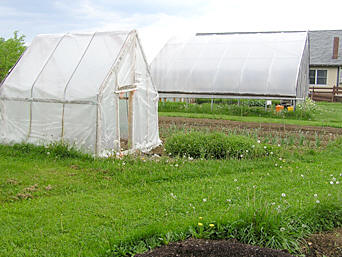 |
| This 8’ x 8’ hoophouse was built from scrap materials and $50 worth of new materials at Unity College, to see if that area could supply greens through the winter. The College’sregulation-sized hoophouse, used in an herbaceous gardening class, is in the background. English photo. |
Troubleshooting on the Ground
by Holli Cederholm
Situated in the center of the Unity College campus in Unity, Maine, a rainbow-shaped swath of vegetable beds offers more than just produce for the college student center. This potpourri is designed to show students how food grows, from seed to seed. Included in this growing area is a production hoophouse, which teaches students how to get a jump on the spring season or fight back the encroaching fall frost. The arching, 24’ x 26’ metal structure, manufactured by Ed Person of Moultonborough, New Hampshire (www.ledgewoodfarm.com), is covered with greenhouse-grade plastic. It offers an impressive opportunity to extend the growing season in cold northern New England.
But, according to Unity student and garden volunteer Sara Trunzo, its size and seamless structure might be more intimidating than inspiring to a novice grower or home gardener. Trunzo and Doug Fox, Professor of Landscape Horticulture, wanted to see the college install a less ambitious hoophouse – something that anybody could build, inexpensively.
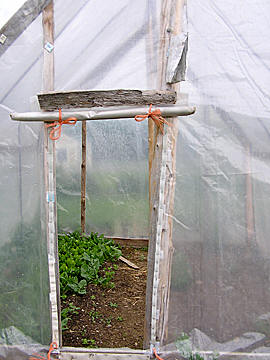 |
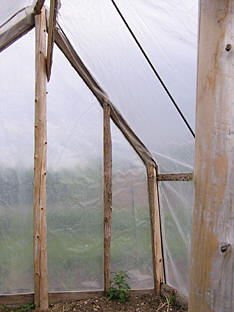 |
| The entrance is simply a piece of plastic that rolls and is held up by twine. English photos. | The back wall. |
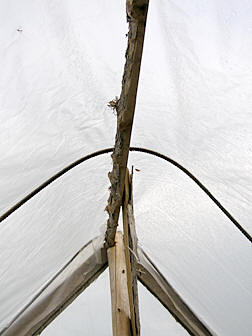 |
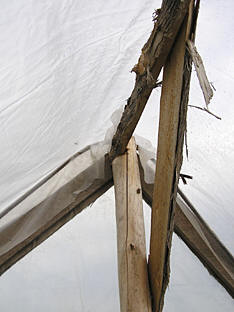 |
| Rebar bends over the top of the house. | A cross piece lends support. |
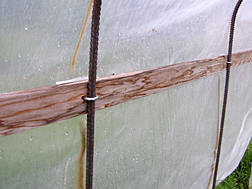 |
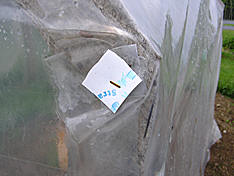 |
| U-bolts hold rebar in place. | Pieces of plastic milk jugs keep the greenhouse plastic from being torn by staples. |
Last year, Trunzo and Fox created a new demonstration garden. Trunzo says she found her inspiration in the food philosophies of Eliot Coleman, commercial market gardener and author of The New Organic Grower. Coleman argues the economics and environmental benefits of extended season gardening, and he claims that one person needs only 8’ by 8’ to grow enough greens to last through the winter.
Trunzo decided to demonstrate how easily Coleman’s theory could become practice.
“I wanted to take his idea really literally, and have it be really cheap,” says Trunzo.
And, she did.
Unity College administrators offered a budget of $50 and permission to experiment. That, Trunzo says, is all it takes.
With the help of Fox and Jason Reynolds (a Unity student at the time; now a graduate), Trunzo built a hoophouse with an 8’ x 8’ footprint. They started by gathering reusable materials, including scrap cedar from local mills and plastic left over from construction of the first hoophouse. The allotted budget went to purchasing rebar for the frame.
The construction was based more on intuition than engineering. Without even sketching a design, Trunzo, Fox and Reynolds began piecing things together.
“First we bent four lengths of rebar so that each one was house-shaped. Then we dug holes and set posts for the end walls,” says Trunzo.
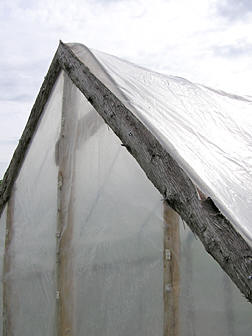 |
| View from outside, back. English photo. |
The four rebar arcs provide most of the structure but are complemented by a ridge-beam, end walls and hip boards of scrap lumber, which provide support for the heavy plastic sheeting. The rebar is secured to the hip boards by U-bolts.
After the frame was up, the plastic was stretched and held in place by staples, with an interface of plastic cut from recycled milk jugs to prevent the staples from tearing the greenhouse plastic.
The trio completed the miniature hoophouse in two afternoons, but Trunzo believes it could be done faster, especially with pre-planning on paper.
A full year after completion, the hoophouse is living up to Trunzo’s ambitions – and then some. It survived a full winter, along with several snowfalls of over 20 inches each. Its plastic is now rust-stained in places and flaps in the breeze, but that’s fine, says Trunzo. The occasional gust of wind exposes a quickly crafted frame of rebar and scrap lumber, along with a love for local food production. Housed beneath this thin sheet of salvaged plastic, spinach broke ground last spring as testimony to an experiment in season extension.
“This hoophouse offers a lot of lessons,” says Trunzo. One concerns fine-tuning Coleman’s theory for a very small structure, which may gain and lose heat faster than a larger hoophouse. Trunzo says that Coleman’s 8’ by 8’ footprint might have been intended as part of a larger hoophouse.
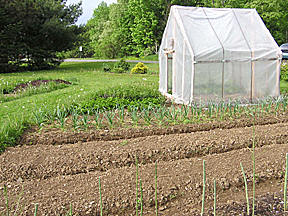  |
| In spring, the tiny hoophouse is bordered by a garden of garlic, asparagus and other vegetables and herbs. English photo. |
Still, she has had some success extending the season with this miniature model. “We’ve had the survival of some things, like mustard greens and kale,” Trunzo notes.
This prototype also taught Trunzo about the importance of design details. Having worked with the hoophouse through a full growing season, she says she might make a few changes, such as fashioning roll-up sides. But, overall, she says she’s satisfied in its demonstration of how a little time and a slight investment can help any household garden through the seasons.
“I like that this hoophouse is homemade,” concludes Trunzo. “People can look at it and say, ‘It doesn’t even look like it’s made that well … I can make it better.’ And then they can go do it.”
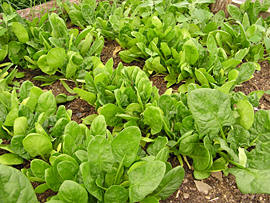  |
| The proof is in the spinach. English photo. |
About the author: Holli Cederholm is a 2007 graduate of the Environmental Writing program at Unity College.
